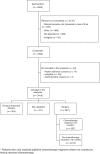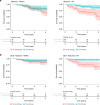Bridging The Age Gap: observational cohort study of effects of chemotherapy and trastuzumab on recurrence, survival and quality of life in older women with early breast cancer
- PMID: 33972747
- PMCID: PMC8292504
- DOI: 10.1038/s41416-021-01388-9
Bridging The Age Gap: observational cohort study of effects of chemotherapy and trastuzumab on recurrence, survival and quality of life in older women with early breast cancer
Abstract
Background: Chemotherapy improves outcomes for high risk early breast cancer (EBC) patients but is infrequently offered to older individuals. This study determined if there are fit older patients with high-risk disease who may benefit from chemotherapy.
Methods: A multicentre, prospective, observational study was performed to determine chemotherapy (±trastuzumab) usage and survival and quality-of-life outcomes in EBC patients aged ≥70 years. Propensity score-matching adjusted for variation in baseline age, fitness and tumour stage.
Results: Three thousands four hundred sixteen women were recruited from 56 UK centres between 2013 and 2018. Two thousands eight hundred eleven (82%) had surgery. 1520/2811 (54%) had high-risk EBC and 2059/2811 (73%) were fit. Chemotherapy was given to 306/1100 (27.8%) fit patients with high-risk EBC. Unmatched comparison of chemotherapy versus no chemotherapy demonstrated reduced metastatic recurrence risk in high-risk patients(hazard ratio [HR] 0.36 [95% CI 0.19-0.68]) and in 541 age, stage and fitness-matched patients(adjusted HR 0.43 [95% CI 0.20-0.92]) but no benefit to overall survival (OS) or breast cancer-specific survival (BCSS) in either group. Chemotherapy improved survival in women with oestrogen receptor (ER)-negative cancer (OS: HR 0.20 [95% CI 0.08-0.49];BCSS: HR 0.12 [95% CI 0.03-0.44]).Transient negative quality-of-life impacts were observed.
Conclusions: Chemotherapy was associated with reduced risk of metastatic recurrence, but survival benefits were only seen in patients with ER-negative cancer. Quality-of-life impacts were significant but transient.
Trial registration: ISRCTN 46099296.
© 2021. The Author(s).
Conflict of interest statement
The authors declare no competing interests. Professors Stephen Walters and Thompson Robinson are National Institute for Health Research (NIHR) Senior Investigators, Jenna Morgan is a NIHR Clinical Lecturer and Kate Lifford is funded by the NIHR as part of this project. The views expressed in this article are those of the author(s) and not necessarily those of the NIHR, or the Department of Health and Social Care.
Figures



References
-
- Cancer Research UK. https://www.cancerresearchuk.org/health-professional/cancer-statistics/s... Accessed January 2021.
-
- Statistics OfN. Cancer survival in England: Patients diagnosed between 2010 and 2014 and followed up to 2015. (Newport, 2016).
-
- Battisti NML, Wallington M, Ring A, Payne S, Birch R, Bomb M, et al. Is age a barrier to chemotherapy? Rates of treatment in older patients treated with breast, colon and lung cancer in England in 2014: a national registry study. Ann. Oncol. 2018;29:viii562–viii575. doi: 10.1093/annonc/mdy297.016. - DOI
-
- Derks MGM, Bastiaannet E, Kiderlen M, Hilling DE, Boelens PG, Walsh PM, et al. Variation in treatment and survival of older patients with non-metastatic breast cancer in five European countries: a population-based cohort study from the EURECCA Breast Cancer Group. Br. J. Cancer. 2018;119:121–129. doi: 10.1038/s41416-018-0090-1. - DOI - PMC - PubMed
Publication types
MeSH terms
Substances
LinkOut - more resources
Full Text Sources
Other Literature Sources
Medical
Miscellaneous

